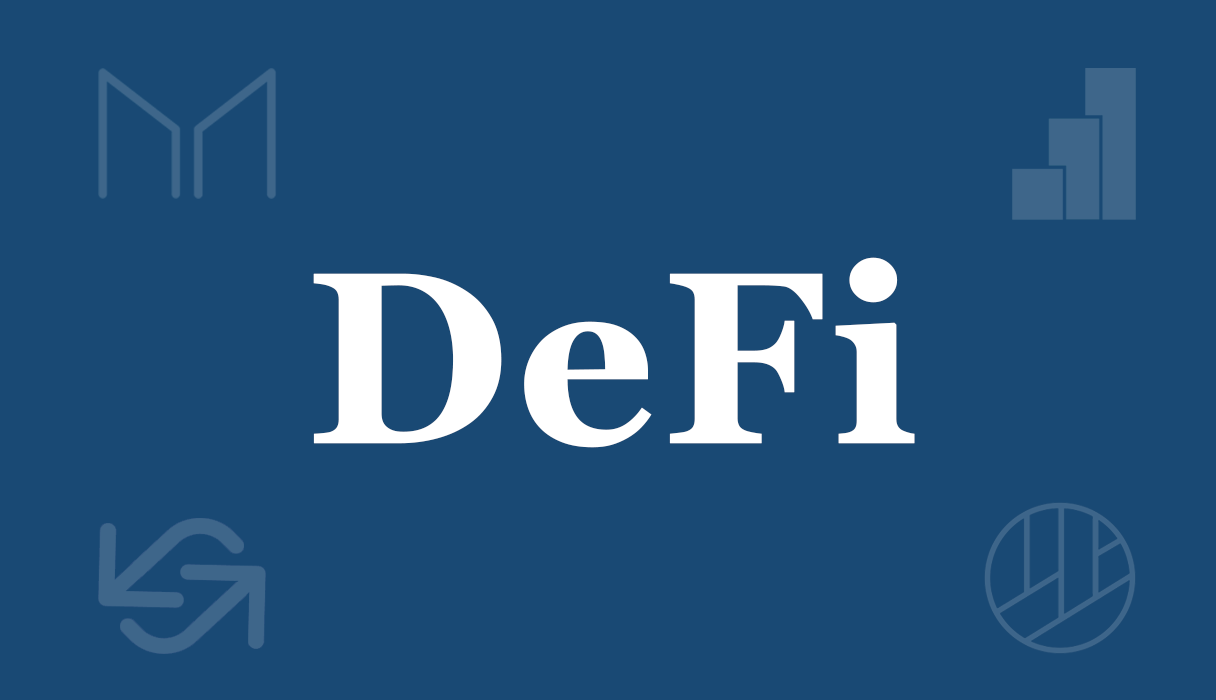3 Projects Not Named Compound That Are Taking over the DeFi World
Jack Choros
Content Marketing
Its daily price movement has only been tracked for about four months, yet the lending platform Compound and its COMP token is changing the game for crypto lending.
Compound is the project responsible for 90% of the hype surrounding DeFi projects throughout the summer. But in the fast-moving world that is cryptocurrency, it’s gone from innovator to pioneer, sparking enough interest from both investors and developers to help spawn several types of DeFi projects that now combine to lock approximately $11 billion USD in smart contracts and blockchains. Other lending platforms, decentralized exchanges, derivatives markets, and all other forms of decentralized finance owe a tip of the cap to Compound for being the first DeFi project to really capture the attention of the broader crypto market (although it’s certainly not the first DeFi project to ever exist).
In a fast-moving market like cryptocurrency is, you might expect Compound to be the most valuable DeFi project by market capitalization, but at the moment, it isn’t. That honour goes to Yearn.Finance (YFI). Yearn.Finance is accompanied by two other notable projects making waves in the DeFi space. One is a fork of the Yearn code, DFI.Money (aka YFII). The other offers a unique, old school looking interface aimed at helping investors do same thing its predecessors are doing. Find the best yields and make investors the most money. That’s Curve.
In this post, we’ll briefly go over what makes Compound so popular and how the other three learned from its predecessor to collectively take over the DeFi world.

A Brief Overview of Compound
Compound is a decentralized lending platform that allows investors and traders alike to both lend out and borrow a wide variety of cryptocurrencies as a way to earn a profit without having to apply for any kind of credit or consult a bank. The Compound.Finance marketplace allows you to look at lending and borrowing rates in a transparent format. You can see the total supply of coins available, the interest rate on that supply, and see the same details on the borrowing side.
While the marketplace is viewable to everyone, like most DeFi projects, the best way to see all of the information at Compound for both the supply and borrowing markets is to connect to app.compound.finance. In order to do this, investors need to get used to doing what most people have to do once they become interested in the DeFi space. Learning how to use a web wallet to store your cryptocurrency or at the very least, to display your hardware wallet balance on your browser. Most investors do this using MetaMask, a Google Chrome extension that can store your crypto directly and provide you with private keys associated with the wallets you create. Or connect directly to a Nano Ledger S, Trezor, or any other hardware wallet.
Why is this important? Because at the present moment, the Ethereum blockchain and its ERC-20 and ERC-721 compliant tokens run the DeFi world. How does that impact the Compound platform? The fact is you can see more information about what’s happening on both the lending and borrowing side of the ledger when your own wallet is connected to the Compound app.
A Side Note About Liquidity
The key word in the phrase DeFi is decentralized. There is no central authority controlling Compound (or Yearn, DFI.Money and Curve for that matter). This means that traders and investors are the ones responsible for providing the liquidity these projects need in order to facilitate the demands of both lenders and borrowers. In exchange for providing liquidity to the network, liquidity providers get COMP tokens. This means you can borrow money to earn COMP. If COMP goes up in value, you can pay off your loan, keep your principal and capitalize on that COMP value. It’s a win, win, win. The need for liquidity and the potential profit associated with providing it is what’s driving the exploding market capitalizations of DeFi projects.
Now that you know a little bit about DeFi’s first real darling, it’s time to learn about how the other three projects compare.

Why Yearn.Finance is the Most Valuable DeFi Project in the World
Make no mistake about it, there are many DeFi projects that bring tremendous value to the crypto space as a whole. But as far as market capitalization goes, YFI stands above them all. Read more about Yearn.Finance (YFI) here.
Andre Cronje is the founder of Yearn.Finance. He focused on earning interest on his crypto holdings well before inventing the project. His reasoning for inventing the YFI protocol is quite simple. Ever since the DeFi bug bit into him and Cronje began looking for the best possible ways to increase his annual yield and earn more crypto, he noticed that dealing with drastically changing rates and trying to chase down the best ones was getting tiring.
Yearn is a smart contract platform that automatically looks for the best rates for you, the investor. The website itself is divided into four categories:
- Vaults
- Earn
- Zap
- Cover
Vaults
Like the description on the website says, vaults maximize your returns and minimize your risk. You’re essentially providing liquidity and getting the best possible rate in return for your contribution.
Earn
Where vaults focus mostly on providing liquidity the earn section of Yearn’s website engages in profit switching. It finds the best possible lending rates between three specific lending projects: Aave, dydx and Compound. You put your capital in and get the best possible rate of return between the three providers. All totally hands-free.
Zap
Apart from the risk of impermanent losses or a decrease in value, perhaps the major drawback that comes from participating in liquidity pools is associated with the fees you have to pay in order to engage in a pool. First you pay a fee to Ethereum network just to access the appropriate smart contracts. Then you pay a separate fee to acquire the appropriate token. Finally, to add that token to a liquidity pool, you have to go beyond swapping for the token and actually do another transaction to enter into the pool. That’s three transactions. If the gas fee is a minimum of four or five dollars on each transaction, you can spend anywhere from $20-$30 just to enter a position in a pool. Zap combines these transactions into one wherever possible, so you save the most money you possibly can on fees.
Cover
Cover essentially allows you to buy insurance against your Yearn investments. Impermanent loss, smart contract flaws or liquidity issues can lead to a loss of funds. Yearn’s Cover function allows you to hedge your bets and buy insurance against your own assets.
The bottom line is Andre Cronje is responsible for creating a more efficient way to enter into the DeFi space and earn the best return possible. If crypto investors at large are proving anything over the past 12 years, it’s that most of them aren’t very loyal. They go wherever the profit is.
With just 30,000 tokens in circulation, the project also benefits from vanity. The idea that a single token in one project can be worth upwards of $25,000 Canadian makes Yearn look expensive, yet the price is enticing enough to lure in investors. Cronje has said many times that the YFI token is nothing but a governance token and that it fundamentally has no value, yet investors are currently holding over $600 million USD in value in the project’s token alone.

Yearn.Finance vs. DFI.Money (YFII)
DFI.Money is very similar to Yearn. There is a reason for that. It’s because DFI.Money (aka YFII) is really just a fork of the original Yearn code. It was invented by Chinese developers. Just like Yearn, DFI.Money offers investors the opportunity to participate in vaults, staking and yield farming.
YFII emulates Yearn in many ways, but the reason for its invention is just as much social and political as it is driven by profit or the decentralization of finance. The founders of YFII are Chinese, and they argue that Yearn is more about Western and corporate interests where YFII is more community driven. Whether or not you care about that as an investor is up to you. But the developers see it that way.
That said, it’s striking up a war between token holders more than it is founders. Cronje is on the record saying that he is more than willing to support YFII. He supports the movement 100%, according to a Twitter post, because it exposes another group of people to crypto and to decentralized finance specifically. So, in a sense, DFI.Money’s main objective is to offer up more tokens to a larger number of people and specifically to get more people in the East to become interested in decentralized finance. While investors may value one over the other and say that the original platform is the only one worth investing in, the overarching goal of both is the same. To make investors wealthier. If you are interested in buying yearn.finance, netcoins offers it!
How Curve.FI Differs from the Competition
Like Compound, Yearn and DFI.Money, Curve’s mandate is to give investors the best possible return on their yield farming endeavours. It’s platform allows you to move capital into different pools and make trades. You can get all kinds of information related to the volume exchanging hands, the annual yield potential and even lock Curve tokens into pools for years at a time to amplify your gains.
One point of difference or advantage that Curve possesses over the competition comes from the fact that the platform allows investors to trade a wide number of derivatives tokens that are tied to the real-world value of cryptocurrencies we all know and love, like Bitcoin and Ethereum for example.
While it’s true that more and more platforms are introducing derivatives or synthetic versions of existing tokens that can live on different blockchains (IE renBTC, Wrapped Bitcoin, wETH etc…), Curve is probably the most popular platform that allows investors to do that. Investors can also leverage a large number of different stablecoins and either lend them out or borrow them. Other platforms of course do this too but again, Curve simply has a wider variety to offer.
Curve.fi is certainly recommended for investors who already feel comfortable with DeFi and understand the value of using derivatives that still tie you to the value of Bitcoin and Ethereum, but allow you to hold onto that value without having to be tied to a specific blockchain. If you’re in Canada and interested in buying Curve (CRV), Netcoins is one of the only regulated exchanges that offer it!

What’s Next for DeFi’s Leading Projects?
With so much hoopla surrounding the DeFi space and the broader crypto community, it’s really tough to say what happens next. If cryptocurrencies move fast, DeFi platforms are moving at the speed of light. Either way, progressive investors have to be excited with what’s happening in the space and as long as you’re in it to win it, not only can you profit, you’ll probably learn a lot.
It’s easy to get greedy when we see projects moving up hundreds of percentage points at a time in value, but don’t forget there’s a bigger picture here. As the world of DeFi accelerates, traditional banks are growing weary and are beginning to understand that if they don’t start offering crypto-related financial services sooner or later, they may get left behind. That’s why crypto exchanges are slowly but surely becoming chartered banks, and it’s why everybody should be paying attention to the DeFi world.
Look no further than getting started with Netcoins. Netcoins is the leading cryptocurrency exchange in Canada. It allows you to invest in Bitcoin, Ethereum and two different stablecoins that can ultimately be used to earn you yields you’ll never get from a bank.
Looking to get started with bitcoin? Netcoins makes it easy for people to buy and sell cryptocurrencies like bitcoin.
Written by: Jack Choros
Writer, content marketing at Netcoins.